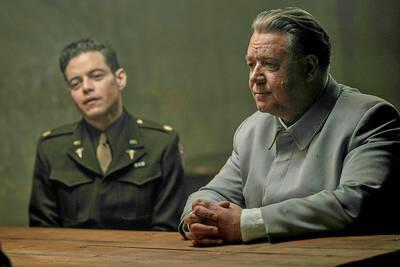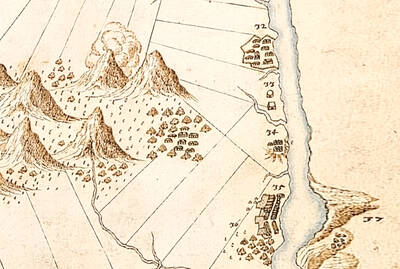Built of wordplay and wit, Lewis Carroll’s Alice books have long defied Hollywood.
They’re too episodic. They appeal to the head, but a good movie needs some heart.
Tim Burton’s Alice in Wonderland has found that heart. Not a lot — Burton is notoriously uncomfortable with emotion — but enough for audiences
to care about a yarn that could easily have been just about art direction.
Drawing from both Alice’s Adventures in Wonderland and Through the Looking-Glass, screenwriter Linda Woolverton has incorporated universal themes of adolescence and self-awareness and adopted the familiar (perhaps too familiar) device of an epic quest to overcome evil.
This time around Alice (Mia Wasikowska) is 19 and no child. In the opening scenes she finds herself an unwilling guest at her own engagement party. Behind her back she’s been steered toward a marriage with an upper-class twit.
Will she accept his proposal, thus ensuring a secure but smothering future for herself and her widowed mum? Or will she defy the conventions of straight-laced Victorian society and carve her own destiny?
Before she can decide, Alice follows a waistcoated White Rabbit down a hole to a magical world she had visited as a child but remembers only as a dream.
Now the odd denizens don’t recognize her — she’s practically a woman, after all. Nevertheless, she’s drawn into a rebellion against the depredations of the comically nasty Red Queen (Helena Bonham Carter).
This land is populated with familiar characters: the Caterpillar, the Cheshire Cat, the March Hare and Dormouse, Tweedledee and Tweedledum. Most are computer-generated and given voices by notables such as Alan Rickman, Timothy Spall and Michael Sheen.
Others are played by actors we recognize, though they’ve been tweaked into fantastic forms. Bonham Carter’s petulant/bombastic Red Queen (a delightfully droll performance) has a huge bulbous head atop a tiny body. Her sneaky courtier, the Knave of Hearts (Crispin Glover), has an impossibly elongated torso that, in his black armor, makes him look reptilian.
And then there’s Johnny Depp’s Mad Hatter, a nominal character in Carroll’s books who here is elevated
to prominence.
Basically he’s the Scarecrow to Alice’s Dorothy, a madcap figure who serves as a confidant and protector.
Though his eyes have been magnified in post production, Depp gives a full-body performance that once again displays his brilliance. His Hatter may be comical, but he’s also a borderline tragic individual who in reflective moments is aware of his own insanity — “I don’t like it in here ... it’s terribly crowded.”
This childlike being nevertheless is heroic, risking his life to depose the Red Queen on behalf of her sister, the virtuous White Queen (Anne Hathaway, leavening a do-gooder character with a dash of subversion).
It all ends with a big battle between red and white armies. But leading up to that is Alice’s discomfort as her role in the conflict becomes clear: She’s expected to don a suit of armor, pick up the legendary “vorpal sword” and slay the Jabberwocky, the Red Queen’s huge dragon.
So in addition to other compelling elements, this Alice is a real heroine, not a passive little girl, who must put aside her fears and rise to the greatness expected of her. This is a very smart move — Alice is a thankless role compared to the scene-chewing possibilities of the surrounding characters, but Wasikowska gives
her the right amount of spunk and fledgling sexuality.
Burton seamlessly integrates his characters — human and animated — within a computer-generated landscape that offers one eye-popping visual after another. There are chases through forests of giant mushrooms, spectacularly designed castles, mysterious rooms and corridors. (The 3D presentation is fine but hardly necessary; this one should look terrific in plain old 2D.)
Every now and then Burton pays homage to the Disney legacy (this Alice is being distributed by the House of Mouse).
Perhaps best of all, Burton never lets his story bog down. There’s always something new to look at, laugh at
or contemplate.
He beat the odds and made this Alice a real wonder.

The Nuremberg trials have inspired filmmakers before, from Stanley Kramer’s 1961 drama to the 2000 television miniseries with Alec Baldwin and Brian Cox. But for the latest take, Nuremberg, writer-director James Vanderbilt focuses on a lesser-known figure: The US Army psychiatrist Douglas Kelley, who after the war was assigned to supervise and evaluate captured Nazi leaders to ensure they were fit for trial (and also keep them alive). But his is a name that had been largely forgotten: He wasn’t even a character in the miniseries. Kelley, portrayed in the film by Rami Malek, was an ambitious sort who saw in

It’s always a pleasure to see something one has long advocated slowly become reality. The late August visit of a delegation to the Philippines led by Deputy Minister of Agriculture Huang Chao-ching (黃昭欽), Chair of Chinese International Economic Cooperation Association Joseph Lyu (呂桔誠) and US-Taiwan Business Council vice president, Lotta Danielsson, was yet another example of how the two nations are drawing closer together. The security threat from the People’s Republic of China (PRC), along with their complementary economies, is finally fostering growth in ties. Interestingly, officials from both sides often refer to a shared Austronesian heritage when arguing for

Among the Nazis who were prosecuted during the Nuremberg trials in 1945 and 1946 was Hitler’s second-in-command, Hermann Goring. Less widely known, though, is the involvement of the US psychiatrist Douglas Kelley, who spent more than 80 hours interviewing and assessing Goring and 21 other Nazi officials prior to the trials. As described in Jack El-Hai’s 2013 book The Nazi and the Psychiatrist, Kelley was charmed by Goring but also haunted by his own conclusion that the Nazis’ atrocities were not specific to that time and place or to those people: they could in fact happen anywhere. He was ultimately

Nov. 17 to Nov. 23 When Kanori Ino surveyed Taipei’s Indigenous settlements in 1896, he found a culture that was fading. Although there was still a “clear line of distinction” between the Ketagalan people and the neighboring Han settlers that had been arriving over the previous 200 years, the former had largely adopted the customs and language of the latter. “Fortunately, some elders still remember their past customs and language. But if we do not hurry and record them now, future researchers will have nothing left but to weep amid the ruins of Indigenous settlements,” he wrote in the Journal of